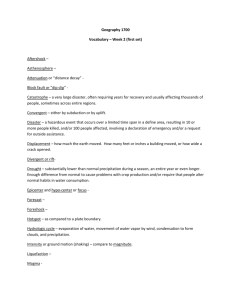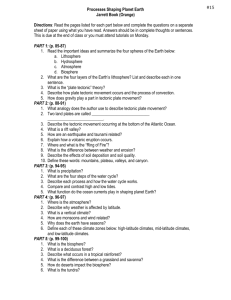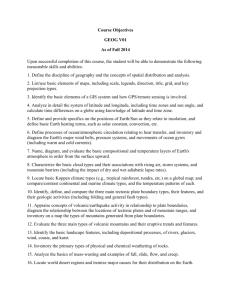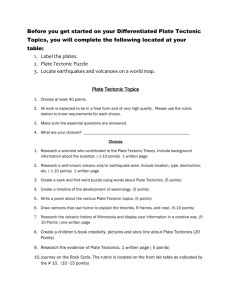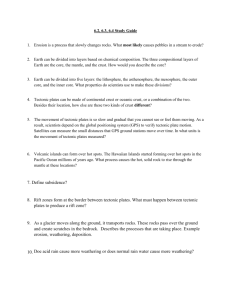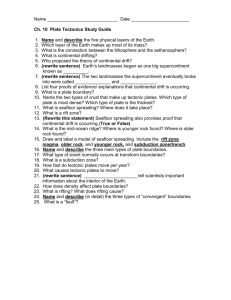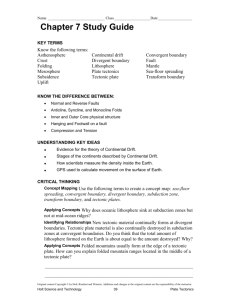71KB - NZQA
advertisement
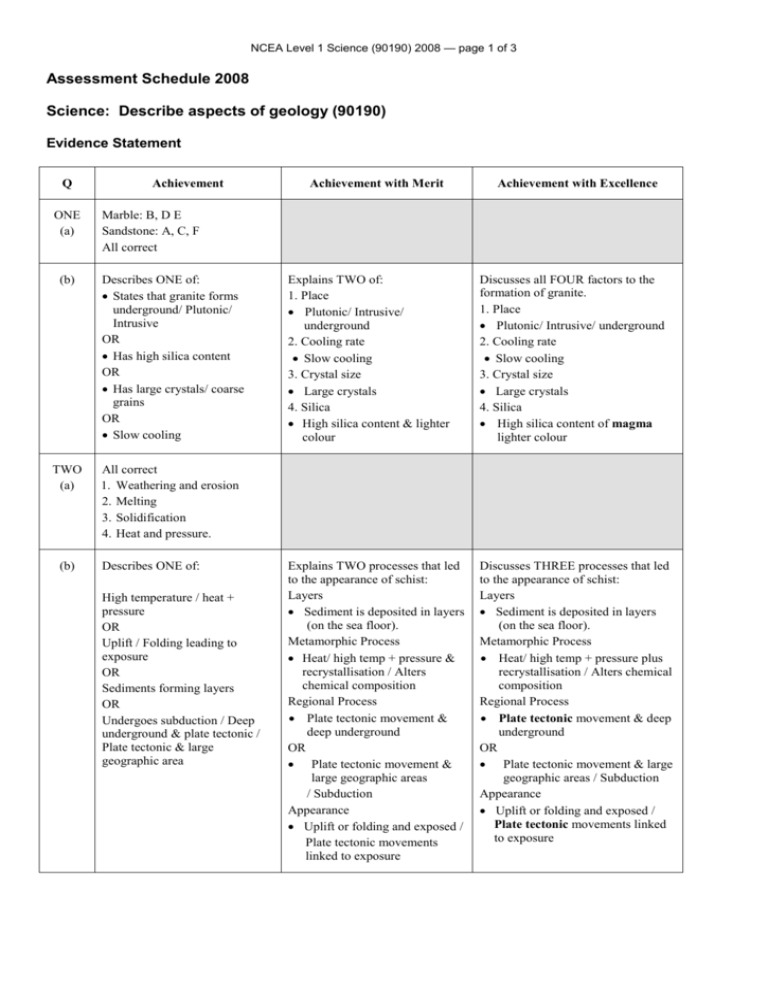
NCEA Level 1 Science (90190) 2008 — page 1 of 3 Assessment Schedule 2008 Science: Describe aspects of geology (90190) Evidence Statement Q ONE (a) Achievement Achievement with Excellence Marble: B, D E Sandstone: A, C, F All correct (b) Describes ONE of: States that granite forms underground/ Plutonic/ Intrusive OR Has high silica content OR Has large crystals/ coarse grains OR Slow cooling TWO (a) All correct 1. Weathering and erosion 2. Melting 3. Solidification 4. Heat and pressure. (b) Achievement with Merit Describes ONE of: High temperature / heat + pressure OR Uplift / Folding leading to exposure OR Sediments forming layers OR Undergoes subduction / Deep underground & plate tectonic / Plate tectonic & large geographic area Explains TWO of: 1. Place Plutonic/ Intrusive/ underground 2. Cooling rate Slow cooling 3. Crystal size Large crystals 4. Silica High silica content & lighter colour Discusses all FOUR factors to the formation of granite. 1. Place Plutonic/ Intrusive/ underground 2. Cooling rate Slow cooling 3. Crystal size Large crystals 4. Silica High silica content of magma lighter colour Explains TWO processes that led to the appearance of schist: Layers Sediment is deposited in layers (on the sea floor). Metamorphic Process Heat/ high temp + pressure & recrystallisation / Alters chemical composition Regional Process Plate tectonic movement & deep underground OR Plate tectonic movement & large geographic areas / Subduction Appearance Uplift or folding and exposed / Plate tectonic movements linked to exposure Discusses THREE processes that led to the appearance of schist: Layers Sediment is deposited in layers (on the sea floor). Metamorphic Process Heat/ high temp + pressure plus recrystallisation / Alters chemical composition Regional Process Plate tectonic movement & deep underground OR Plate tectonic movement & large geographic areas / Subduction Appearance Uplift or folding and exposed / Plate tectonic movements linked to exposure NCEA Level 1 Science (90190) 2008 — page 2 of 3 (c) THREE (a) (b) Describes one aspect of moving particles. Size of particles are explained along with transport & erosion. Compare size of particles with transport & erosion. Big boulders are hard / too heavy to move / transport. OR Sand / gravel easy to move. OR Boulders break down into gravel (erosion). OR Sand / gravel have moved a distance (Boulders not moved). OR Insufficient energy / current to move boulders. OR Mountain streams have enough energy to transport small & gravel. Large boulders have had short time / not enough distance from the source / insufficient energy to be broken down into a small sized rock particle. OR Sand and gravel have travelled for a long time / far enough distance from the source / sufficient energy to be broken down into a small sized rock particles. Large boulders have had shorter time / not enough distance from the source / insufficient energy to be broken down into smaller sized rock particles. OR Sand and gravel have travelled for a longer time / far enough distance from the source / sufficient energy to be broken down into smaller sized rock particles. Describe one geological event/ process or environment relating to a rock formation. Explain one geological event/ process and environment relating to a rock formation. Relate or Justify two consecutive geological events/ processes and environments in relation to the rock formations. Refer to table below. Refer to table below. All correct: BDEAFC Sequence B Mudstone D Limestone B-D Mudstonelimestone D Limestone Uncomformity E,A,F Event/ Process Sediment deposition Environment Low energy Uplift Mountain building Ocean basing forming Folding (Shallow) seas Uplift/ sea level falling Erosion Land sinking Deposition of sediments C Description of Intrusion Tectonic plate movement Subduction Plate tectonics Exposed Above sea level Limestone submerged again Sea level rising Sandstone from a high energy environment Siltstone & mudstone from a low energy environment Hot spot Subduction Tectonic movements Justification Examples: C is formed by a subduction zone forcing magma up through all layers making C the youngest rock. Folding occurs after layers B and D have been deposited as the rocks above are horizontal. Limestone above water due to uplift. Erosion of limestone forms the unconformity between the sandstone. Relate Change in sequence from event / process and environment to the next sequences event / process and environment (use the table to help). Eg Relating the formation of B (mudstone) sediment deposition caused by low energy, followed by uplift, forming shallow warm seas, which led to the deposition of marine animals. NCEA Level 1 Science (90190) 2008 — page 3 of 3 (c) Describe that: Rocks with the same fossil species in them are the same age. OR Describes the fossil to an environment. OR Fossils present in a specific time range (Appearance or disappearance of a fossil). Fossils that have a specific time range before extinction are used to establish age ranges of the fossil therefore the rocks they are found in can be relatively dated (explanation). AND Identifies the environment as the same (therefore same rock type). Judgement Statement Achievement Achievement with Merit Achievement with Excellence Total of FIVE opportunities answered at Achievement (or higher). Total of SIX opportunities answered with TWO at Merit (or higher) and FOUR at Achievement level (or higher). Total of SIX opportunities answered with ONE at Excellence, THREE at Merit and TWO at Achievement level (or higher). 5A 2M + 4A 1E+3M+2A
